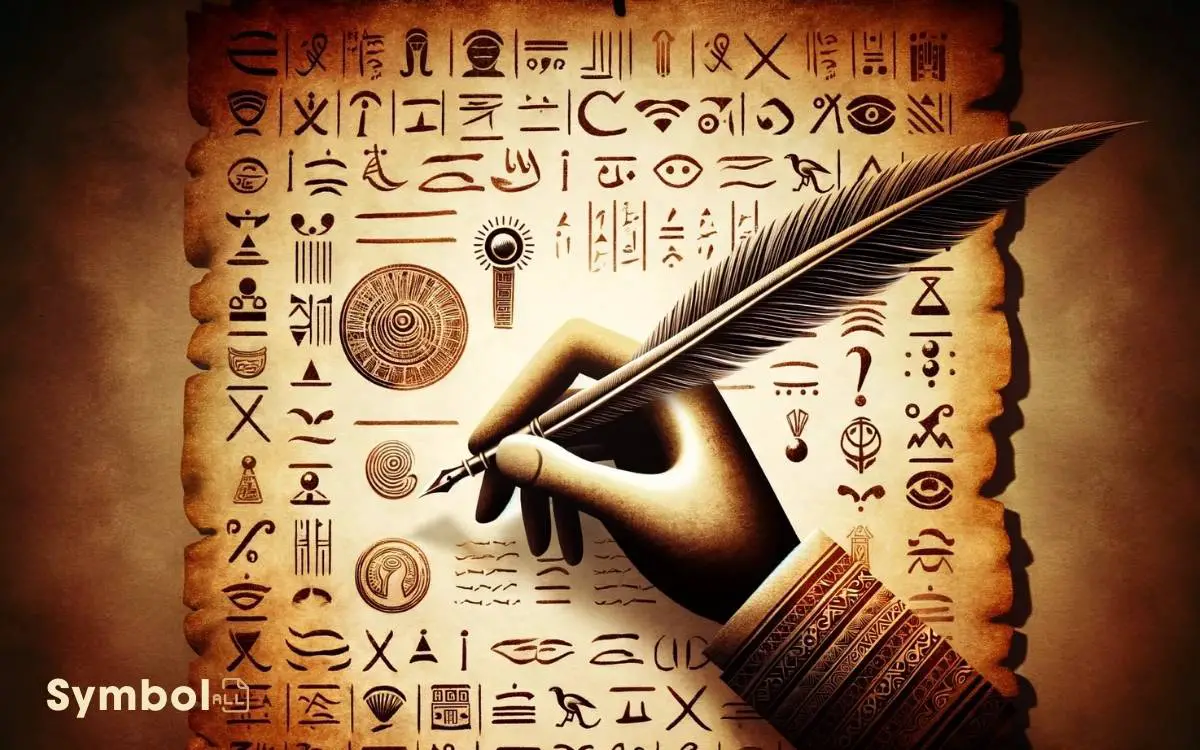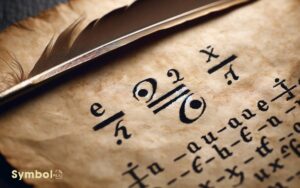A Symbol Used to Write a Number: Explains!
A symbol used to write a number is part of a system that humans developed thousands of years ago to communicate quantities. Over time, these symbols evolved from simple tallies to the sophisticated numerals you use today.
Ancient civilizations, like the Egyptians and Babylonians, made significant contributions, introducing concepts like zero, which transformed mathematics.
The numeral systems have gone through numerous innovations, with Hindu-Arabic numerals becoming the global standard. These symbols allow for efficient calculation and universal communication, impacting everything from commerce to digital technology.
Your everyday life is filled with these numerals, and understanding their history enriches their significance in your world.

Key Takeaways
Origins of Numerical Symbols
Humanity’s journey with numerical symbols began thousands of years ago, marking a pivotal advancement in our ability to record and communicate complex information.
You’ve likely taken for granted the ease with which you can jot down numbers, from the essential tasks of listing phone numbers to more complex operations like calculating budgets.
This convenience stems from a rich history of evolving numerical expressions, moving from simple tally marks carved into bones or stones to sophisticated systems that allowed for calculations of great complexity.
Before delving into the contributions of ancient civilizations, it’s vital to appreciate this evolution. It represents humanity’s relentless pursuit of precision and efficiency in quantification.
This shift didn’t just change how we managed trade or kept records; it fundamentally transformed our ability to understand and manipulate the world around us.
The Role of Ancient Civilizations
Ancient civilizations played an essential role in developing the numerical symbols we use today, refining and passing on their innovations through generations.
The ingenuity of these early cultures set the foundation for the complex mathematical and computational systems that you now take for granted. Their contributions aren’t just historical footnotes; they’re the bedrock of modern science, economics, and technology.
- The Egyptians’ use of hieroglyphs for counting revolutionized trade and commerce.
- Babylonians introduced the concept of zero, a groundbreaking moment in mathematics.
- The Mayans developed an advanced calendar system relying heavily on their numerical understanding.
- Roman numerals, though less used today, facilitated the administration of an empire.
Each bullet point underscores a legacy that impacts your daily life, highlighting the timeless value of their advancements.
Evolution of the Numeral System
Building on the legacy of early civilizations, the numeral system underwent significant evolution to become the efficient tool you rely on today.
Initially, simple notches on bones or stones marked quantities, but as societies grew, the need for more complex systems became apparent.
The Egyptians and Babylonians developed their unique numeral systems, utilizing symbols and positional values for more significant numbers.
The Greeks and Romans further refined these concepts, introducing alphabetic numerals and the concept of subtraction for denoting numbers.
However, it was the Hindu-Arabic numeral system that revolutionized the way you perceive numbers today.
Its introduction of positional notation and the use of distinct symbols for each digit from one to nine enabled more straightforward calculation processes, setting the stage for modern mathematics and computational methods.
The Concept of Zero
You might wonder how the concept of zero came to be and its significance in mathematics.
The origins of zero mark a pivotal moment in numerical systems, transforming how numbers are understood and utilized.
Understanding zero’s mathematical impact reveals its role as more than just a placeholder, but as a cornerstone in the foundation of modern mathematics.
Origins of Zero
To fully understand the concept of zero, it’s essential to explore its origins, which trace back to ancient civilizations that acknowledged the necessity for a symbol to represent the absence of quantity.
These cultures recognized the profound impact that a simple placeholder could have on mathematics, trade, and the recording of information.
- The Babylonians utilized a placeholder in their number system around 300 BC, yet it wasn’t a true zero.
- Ancient Mayans independently developed a concept of zero by the 4th century AD, enriching their astronomical studies.
- The symbol for zero as we understand it was crystallized by Indian mathematicians around the 5th century.
- This concept reached Europe through Arabic scholars, transforming the mathematical landscape.
Understanding zero’s journey highlights our shared human endeavor to comprehend the universe, stirring a deep appreciation for this revolutionary concept.
Zeros Mathematical Impact
The concept of zero revolutionized mathematics by introducing the notion of representing nothingness in a tangible, operational form. Before its widespread acceptance, the absence of value had no placeholder, making complex calculations almost impossible.
You can imagine how zero’s introduction transformed math, allowing for the development of algebra, calculus, and the binary number system, which is fundamental in computing. It’s not just a symbol; it’s a concept that underpins the entire digital age.
By enabling negative numbers, zero provided a way to express loss or debt, further expanding math’s scope. It’s the foundation of modern mathematics and science. Without zero, you wouldn’t have the precise tools needed for engineering, physics, or finance.
Zero’s mathematical impact is profound, serving as a cornerstone for numerical and scientific advancements.
Roman Numerals and Their Legacy
Roman numerals, an ancient system for representing numbers, continue to influence modern society in various ways.
You’ll find them gracing the faces of clocks, emphasizing the grandeur of historical monuments, and marking significant chapters in books. They serve as a bridge to our past, reminding us of the ingenuity of ancient civilizations.
Consider their presence in:
- Clock faces, where they add an air of timelessness and elegance.
- Monuments and buildings, evoking the grand history and architectural prowess of ancient Rome.
- Movie and event titles, lending a sense of importance and tradition.
- Book chapters and outlines, offering clarity and a classic touch to literature.
Their legacy isn’t just about numbers; it’s about connecting us with history, enriching our cultural landscape, and inspiring a sense of continuity and respect for the past.
Arabic Numerals: A Global Standard
You’ve seen how Roman numerals paved the way, but it’s the Arabic numerals that have become the global standard.
Their origin and spread across cultures have transformed the way we write numbers today.
Let’s explore how this system impacted mathematics and why it’s universally adopted.
Origin and Spread
Originating in the Indian subcontinent, Arabic numerals were adopted by the Arab world and later spread to Europe, becoming the global standard for writing numbers.
This journey from local use to worldwide acceptance is both fascinating and impactful. It’s a proof of the power of cultural exchange and innovation.
Consider how this spread has affected you:
- You effortlessly communicate large, precise numbers.
- Financial transactions are streamlined, regardless of the country.
- Complex scientific and mathematical concepts are accessible.
- Everyday tasks, like dialing phone numbers, are simplified.
These numerals are more than just symbols; they’re bridges connecting diverse cultures and fields. Their adoption showcases humanity’s shared quest for efficiency, understanding, and progress.
Impact on Mathematics
As Arabic numerals became the global standard, their impact on mathematics profoundly transformed how we approach and solve complex problems. You now find it easier to perform calculations, understand mathematical concepts, and communicate findings universally. This shift not only streamlined arithmetic but also laid the foundation for advancements in algebra, calculus, and the sciences. Arabic numerals and their meaning became central to the development of modern banking, trade, and technology, facilitating a shared numerical language across diverse cultures. Their simplicity and efficiency continue to shape our understanding of the numerical world today.
| Impact on Math | Description |
|---|---|
| Enhanced Calculations | Simplified arithmetic operations. |
| Universal Language | Standardized number representation. |
| Scientific Advancement | Enabled complex problem-solving. |
| Educational Accessibility | Made math more teachable and learnable. |
| Technological Integration | Facilitated coding and digital development. |
This shift not only streamlined mathematical operations but also bridged cultural and linguistic divides, making math a truly global language.
You’re part of a world where numbers open up endless possibilities, from the depths of space exploration to the intricacies of quantum computing.
Mathematical Symbols Beyond Numbers
Mathematics’ language extends beyond numbers, incorporating symbols that reveal the universe’s most complex equations.
When you explore into this symbolic world, you’re not just discovering a new way to communicate; you’re revealing the hidden patterns that govern everything from the microscopic to the cosmic scale.
These symbols serve as the bridge between abstract concepts and tangible understanding.
- Pi (π) evokes the endless beauty of circles and the mysteries they contain.
- Infinity (∞) symbolizes the boundless possibilities within mathematics and life.
- The integral sign (∫) invites you to investigate areas under curves, connecting seemingly disparate points.
- The square root (√) represents the foundational quest for understanding, breaking down complex problems into their simplest forms.
Each symbol is a key, revealing doors to worlds waiting to be explored.
The Influence of Mathematics on Culture
Throughout history, mathematical principles have profoundly shaped cultures worldwide, influencing art, architecture, and philosophy.
You’ll find the Golden Ratio in the proportions of the Parthenon and the Fibonacci sequence in the spirals of sunflowers, demonstrating how deeply math is woven into the fabric of our world.
| Culture | Mathematical Influence |
|---|---|
| Ancient Egypt | Pyramid construction |
| Renaissance Art | Perspective and proportion |
| Islamic Art | Geometric patterns |
| Modern Architecture | Minimalist design principles |
| Music Composition | Harmonic patterns |
These examples show how mathematics isn’t just about numbers and equations; it’s a universal language that shapes how you perceive and interact with the world.
From the symmetry in nature to the rhythm in music, math’s influence on culture is both profound and perpetual, guiding human creativity and innovation across centuries.
Numerals in the Digital Age
Building on the profound impact of mathematics on culture, the digital age has further evolved how we use numerals in everyday life. You’re now interacting with numbers in ways previously unimaginable, seamlessly integrating them into your digital experiences.
- You feel secure as you enter a PIN, knowing your financial transactions are protected.
- Joy fills you when your fitness tracker shows you’ve met your step goal, all quantified.
- Frustration arises when a website’s captcha challenges you, yet it’s just another form of numerical interaction.
- Curiosity drives you to track your online order, a journey told through numbers.
This evolution showcases not just a shift in how numerals are used, but how they’ve become a deeply emotional part of our digital narratives.
Future Trends in Numerical Notation
As you look toward the horizon of numerical notation, you’ll notice a significant shift influenced by digital notation evolution, global standardization efforts, and AI integration.
These changes are poised to redefine how you interact with numbers, ensuring a more unified and efficient approach to numeracy worldwide.
With these advancements, you’re stepping into an era where numbers aren’t just symbols, but dynamic tools seamlessly integrated into the digital fabric of society.
Digital Notation Evolution
Exploring the future trends in numerical notation, you’ll notice digital notation is rapidly evolving to meet the demands of modern technology and data analysis.
This evolution isn’t just about changing symbols but about how these symbols facilitate faster, more efficient data processing and interpretation.
Consider the implications:
- Enhanced data compression techniques for storing vast numbers efficiently.
- Improved algorithms for quicker numerical analysis and calculations.
- More intuitive digital interfaces for seamless human-computer interaction.
- Advanced encryption methods for secure numerical data transmission.
These advancements promise to revolutionize the way you interact with numbers, making data analysis more precise and accessible.
The future of numerical notation lies in its ability to adapt, ensuring that as our digital world grows, our methods for representing numbers remain robust, secure, and incredibly efficient.
Global Standardization Efforts
In the domain of numerical notation, worldwide standardization efforts are essential to ensuring consistent, efficient communication across diverse digital platforms.
These endeavors aim to unify the various systems and symbols used to represent numbers, making it easier for people around the globe to share and understand numerical information.
Such initiatives involve collaboration among international standards organizations, governments, and the tech industry. They’re focused on creating a common framework that supports the seamless exchange of data, irrespective of geographic or cultural boundaries.
This push towards uniformity doesn’t just facilitate global commerce and scientific research; it also helps in educating and connecting communities.
AI Integration in Numeracy
The integration of AI into numeracy is set to revolutionize how we comprehend and utilize numerical notation in the coming years. You’ll witness a transformation that not only enhances precision but also makes mathematics more accessible and engaging.
Imagine a future where:
- Complex calculations become as straightforward as typing a question into a search engine.
- Personalized learning algorithms adapt to your pace, making math less intimidating.
- Real-time data analysis tools empower you to make informed decisions with ease.
- Virtual reality settings offer immersive experiences, turning abstract concepts into tangible understanding.
This future isn’t far off. As AI continues to evolve, its integration into numeracy promises to break down barriers, making the language of numbers a universal tool for innovation and discovery.
Unraveling the Mysteries of Pi
Plunge into the depths of Pi, a mathematical constant that has captivated mathematicians for centuries. Represented by the Greek letter ‘π,’ this number is essential in calculating the circumference of a circle relative to its diameter.
Despite its simple appearance, Pi’s complexity lies in its infinite, non-repeating decimal expansion, making it an irrational number. You can’t pinpoint its exact value, but it’s commonly approximated as 3.14159.
Its discovery isn’t attributed to a single individual; rather, it’s a culmination of work from various cultures, including the Babylonians and Egyptians.
Today, Pi plays a critical role not just in geometry, but in trigonometry, calculus, and physics, proving its indispensable nature in understanding the universe’s fabric.
Conclusion
You’ve journeyed through the evolution of numerical symbols, from ancient origins to digital frontiers. Understandably, you might question the relevance of understanding ancient numeral systems in today’s tech-driven world.
Yet, visualizing the shift from Roman numerals to modern digits illuminates not just our mathematical progress but how deeply numbers are woven into our cultural fabric.
As we venture into future numerical innovations, remember, these symbols are more than mere tools; they’re a proof of humanity’s enduring quest to quantify the universe.





